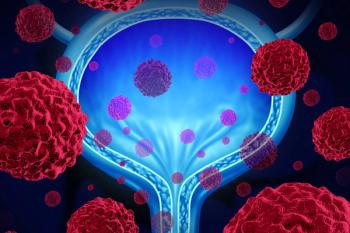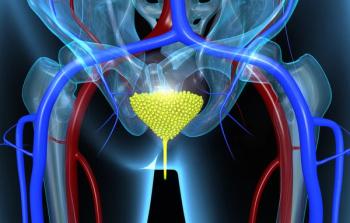
- ONCOLOGY Vol 12 No 12
- Volume 12
- Issue 12
Predicting Prognosis in Patients With Superficial Bladder Cancer
Superficial transitional cell carcinoma of the bladder comprises an extremely heterogeneous group of tumors, both in terms of morphology and, even more importantly, in terms of tumor biology and clinical behavior. Drs. deVere White and Stapp provide a succinct overview of the challenges encountered clinically because of tumor heterogeneity and the availability of different treatment options. The authors also outline the use of traditional prognostic factors (clinicopathologic characteristics) and the current state of development of biological markers that hold promise in providing significant clinically useful prognostic information.
Superficial transitional cell carcinoma of the bladder comprises an extremely heterogeneous group of tumors, both in terms of morphology and, even more importantly, in terms of tumor biology and clinical behavior. Drs. deVere White and Stapp provide a succinct overview of the challenges encountered clinically because of tumor heterogeneity and the availability of different treatment options. The authors also outline the use of traditional prognostic factors (clinicopathologic characteristics) and the current state of development of biological markers that hold promise in providing significant clinically useful prognostic information.
Biology and Natural History of Superficial Bladder Tumors
The majority (70% to 80%) of bladder cancers are superficial tumors confined to the epithelium or submucosa. Most papillary superficial tumors (70%) are limited to the mucosa (stage Ta), but some may also (30%) invade into the lamina propria (stage T1), where the tumor may gain access by invasion into blood vessels and/or lymphatics.
Superficial transitional cell carcinoma of the bladder also includes flat carcinoma in situ, which is characterized by high-grade malignant cells confined to the epithelium. This form of disease most commonly occurs in association with other superficial or invasive bladder tumors or in patients with a history of previous bladder tumors.
There is a striking relationship between grade and whether or not a papillary tumor is confined to the epithelium or invades into the lamina propria. The vast majority of Ta tumors are low grade. Although these tumors have a propensity for recurrence, they almost always recur as low-grade Ta tumors and only rarely pose a threat to the patients life. In contrast, most T1 tumors are high grade and life-threatening. In addition to an even greater propensity for recurrence, progression to muscle invasion occurs in 20% to 30% of patients with T1 tumors and in up to 50% of patients with associated carcinoma in situ.
Although initially proposed on the basis of clinicopathologic characteristics, molecular genetic analysis has revealed separate underlying events associated, on the one hand, with low-grade superficial tumors and, on the other, with high-grade carcinoma in situ and invasive cancers.[1] It is anticipated that with further characterization of these molecular events, markers will become available that will be useful in the clinical setting to stratify patients. This, in turn, will lead to appropriate treatment based on the tumors predicted natural history and response to treatment.
Treatment Considerations
The goals of managing patients with superficial transitional cell carcinoma of the bladder are to eliminate existing disease and to prevent or delay recurrence and progression. Initial therapy consists of endoscopic transurethral resection, followed by intravesical therapy in patients judged to be at high risk for either recurrence or progression. Important, fundamental questions have been raised about this approach. It remains controversial whether or not prophylactic intravesical therapy alters the ultimate course of the disease, including progression and survival.
Because of the potential for progression and the inaccuracies of clinical staging, some authors recommend radical cystectomy following the diagnosis of high-grade T1 tumors. Contemporary series document long-term survival rates of up to 80% following radical cystectomy for pathologic organ-confined disease.[2-4] Therefore, aggressive surgical management prior to progression and its attendant risks of metastasis remains an important, potentially life-saving treatment approach for patients who present with poorly differentiated stage T1 bladder cancers. Certainly, patients with superficial bladder tumors who are at high risk for progression require aggressive local treatment and prompt
cystectomy when intense surveillance documents treatment failure. Ideally, patients at low risk should be followed on a less intense surveillance schedule and spared aggressive local treatment.
Use of Tumor Markers
Because of the variable natural history of tumors of similar morphology, grade, and stage, there is a need for the development of tumor markers useful in the management of patients with these tumors. As outlined by Drs. deVere White and Stapp, a host of potential biological markers have been evaluated in superficial bladder cancer. These include abnormalities in DNA content and S-phase fraction, blood group and other tumor-associated antigens and monoclonal antibodies, tumor-suppressor genes, oncogenes, growth factors and receptors, cell adhesion molecules, and markers of tumor angiogenesis.
A number of important considerations apply to most studies of potential biological markers in bladder cancer. The majority have been retrospective studies in select small groups of patients, analogous to clinical phase I/II trials. Although a number of markers, including TP53 and RB1, appear to be promising and have been correlated with various end points, including recurrence, progression, and survival, most studies have not shown that these markers provide prognostic information independent of tumor grade and stage.
Most importantly, none of the marker tests has been standardized and validated in a prospective fashion in trials analogous to clinical phase III studies. These types of well-designed studies incorporating multivariate analyses are necessary to definitively demonstrate whether or not a marker (or, more likely, a panel of markers) provides in-dependently significant prognostic information. It is only through this type of rigorous evaluation of tumor markers that the level of confidence necessary to influence clinical decision-making can be established. Considering the rapid progress made over the past decade, we fully anticipate that this type of information will be forthcoming in the not too distant future and will be assimilated into standard clinical practice.
References:
1. Spruck CH, Ohneseit PF, Gonzalezzulueta M, et al: Two molecular pathways to transitional cell carcinoma of the bladder. Cancer Res 54:784, 1994.
2. Malkowicz SB, Nichols P, Lieskovsky G, et al: The role of radical cystectomy in the management of high-grade superficial bladder cancer (PA, P1, PIS, and P2). J Urol 144:641, 1990.
3. Pagano F, Bassi P, Prayer T, et al: Results of contemporary radical cystectomy for invasive bladder cancer: A clinicopathological study with an emphasis on the inadequacy of the tumor, nodes, and metastases classification. J Urol 145:45, 1991.
4. Freeman JA, Esrig D, Stein JP, et al: Radical cystectomy for high-risk patients with superficial bladder cancer in the era of orthotopic urinary reconstruction. Cancer 76:833, 1995.
Articles in this issue
about 27 years ago
Monoclonal Antibody Approved for Metastatic Breast Cancerabout 27 years ago
Booklet Provides Guidance on Appointing or Being a Health Care Proxyabout 27 years ago
Lower Genital Tract Neoplasia in Women With HIV Infectionabout 27 years ago
Clinical Status and Optimal Use of Rituximab for B-Cell LymphomasNewsletter
Stay up to date on recent advances in the multidisciplinary approach to cancer.

















































































